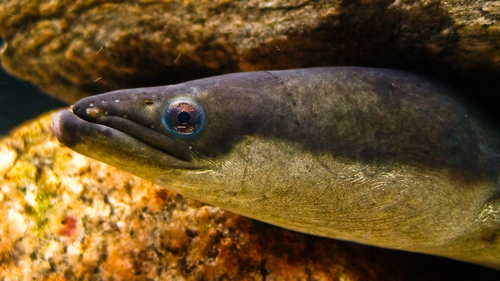
American Eel
The Atlantic bluefin tuna (Thunnus thynnus) is a majestic and powerful fish, renowned for its size, speed, and commercial value. It is a highly migratory species, capable of crossing vast oceanic distances. This species plays a critical role in the marine ecosystem and has significant cultural and economic importance.
5 40 years
Lifespan
150 cm
Length
Endangered
Conservation Status
5 km/h
Swimming speed
Carnivorous
Diet
Catadromous Migration
Migration
Appearance Overview
The Atlantic bluefin tuna is a large, torpedo-shaped fish with a metallic blue-black back and a silvery-white underside.
Coloration
Dark metallic blue on top, silvery-white underside
Fins
Two dorsal fins, the first depressible; small finlets behind second dorsal and anal fins
Body Shape
Torpedo-shaped, streamlined body built for speed and endurance
Length
Up to 13 feet (4 meters)
Weight
Up to 2,000 lbs (907 kg)
Diet
Carnivorous, feeding on a variety of fish, squid, crustaceans, and eels.
Feeding Behavior
Highly opportunistic predators, they use their speed and agility to hunt, often working cooperatively to herd and capture prey.
Social Behavior
Forms large schools, sometimes segregated by size; highly migratory, capable of crossing entire oceans.
Commercial Relevance
Extremely high value, particularly in the sushi and sashimi markets in Japan; one of the most expensive fish in the world.
Conservation measures
Subject to international fishing quotas and regulations; marine protected areas; ongoing research and monitoring efforts.
Status
Endangered (Varies by population segment; some are considered critically endangered)
Threats
Overfishing (historically and, in some areas, continuing); bycatch in fisheries targeting other species; habitat degradation.
Habitat Distribution
Depth Range
0-1,000 meters (surface to depths)
Geographic Range
North Atlantic Ocean, Mediterranean Sea, and formerly the Black Sea.
Preferred Environment
Primarily pelagic (open ocean), but also found in coastal waters; prefers temperate waters.
Reproduction and Life Cycle
Breeding Habits
Spawns in two main areas: the Mediterranean Sea and the Gulf of Mexico; spawning occurs in warm waters during specific seasons.
Development Stages
Eggs hatch into larvae; rapid growth in the first year; juveniles mature into adults over several years.
Fecundity
Highly fecund; females can release up to 30 million eggs per spawning season.
Maturity Age
Maturity varies by location; Mediterranean population matures at around 4 years, while the western Atlantic population matures around 8 years.
Faqs about American Eel
Where are Atlantic bluefin tuna found?
Atlantic bluefin tuna are found throughout the North Atlantic Ocean and the Mediterranean Sea.
How long do bluefin tuna live?
Atlantic bluefin tuna can live up to 40 years.
What do Atlantic bluefin tuna eat?
They primarily eat a variety of fish, squid, crustaceans, and eels.
Are Atlantic bluefin tuna migratory?
Yes, they are highly migratory and can cross entire oceans.
What is the biggest threat to bluefin tuna?
Overfishing is the primary threat to Atlantic bluefin tuna populations.
How fast can a bluefin tuna swim?
They are among the fastest fish in the ocean, capable of bursts of speed up to 43 mph (70 km/h).
Are bluefin tuna warm-blooded?
Atlantic bluefin tuna have a unique ability to maintain a body temperature higher than the surrounding water, allowing them to thrive in a wide range of temperatures.
How much does a single bluefin tuna cost?
The value depends on many factors, like quality, size, market, and the origin, wild-caught or farmed. A single tuna can cost from tens of thousands up to millions of dollars.
Copyright @ Nature Style Limited. All Rights Reserved.
 English
English